I've had such great success with my baker's cyst! It's really given me noticeable improvements. I'm very happy with the products, so now I've ordered the Back BFST.
Connie from New JerseyColdCure Leg | BFST Knee | Pre-Cut TapeJuly 15, 2022


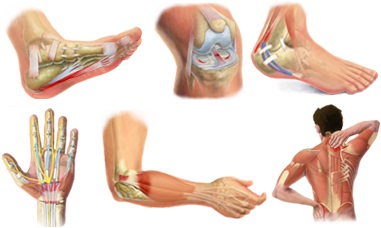
A Tendon is a very strong rope like tissue that attaches to just one bone. The other end of the tendon fans out, or splays, into your muscles. When you want to move, your muscles contract to pull the tendons, and that causes the bones to move. The Tendons are what your muscles use to pull on your bones to cause your joints to bend and your limbs to move.
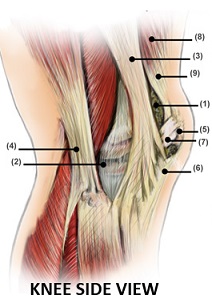
Ligaments are the ropes in your body that connect just to your bones. A Ligament is a rope-like tissue that holds the ends of two bones together. Your ligaments hold your joints together so the bones don't slip out of place when you move. When your tendon pulls a bone to move it, a ligament is holding the end in place so it doesn't slip from the joint. So generally, ligaments are attached at the very end of bones and tendons are attached a little further down the bone.
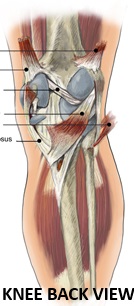
Tendons and ligaments are actually more like steel cables than ropes. They are incredibly strong. They do not really stretch - they are not supposed to stretch. There is some 'give' to a tendon but if it is pulled too tightly it suffers damage. A safe amount of stretch is 2%-4%, so in a long tendon that's 8 inches long, that amount of allowable stretch is less than a third of an inch. In small tendons it can be only a sixteenth of an inch. Practically speaking, tendons don't really stretch. When we talk about 'stretching' as it applies to parts of your body being flexible, we're actually talking about stretching the muscles, not the tendons and ligaments. When you practice stretching to improve your range of motion, you are always talking about training and conditioning the muscles to stretch.
There are lots of joints where the muscle is pretty far away from the bone it is pulling on. Think about your calf muscle pulling on your foot to straighten it, or your hamstring pulling on your lower leg bone when you bend at your knee. Most tendons are long like this and, when that's the case, the tendon is enclosed in a guiding pipe over the joint called a 'tendon sheath' Inside that pipe or sheath, the tendon is constantly moving back and forth to extend or bend the joint.
The tendon sheath is made from something called 'synovial membrane' which is a type of tissue that is super tough and super slippery. The sheath is held in place in your joint by fibrous tissues along its exterior connecting to other tissue and bone along the path. There are also some natural pulley type structures that help guide it through the major bends. There's lots of structure holding the tendon sheath so it always stays in the right place. Your body also creates something called 'synovial fluid' inside the sheath which is like oil and nourishment for the tendon to keep it healthy and to reduce the wear and tear of the constant motion.
So, the tendons are like steel cables, the sheath is like a guide pipe, and the synovial fluid is lubricating oil. As your muscles pull the tendon cable through the sheath pipe, on the other end, the tendon pulls on your bones so your bones move. While your tendons are pulling your bones back and forth, other steel cables (your ligaments) are holding the ends of the bones in place so they keep the joint together.
It's also worth noting that unlike how we think about ropes and cables, tendons do not have the same shape along their length. In the middle of the tendon sheath, they are sometimes more round like a cable. But a lot of the time, the tendon is more like a ribbon than a cable along part or all of its length. Whether it is quite flat or quite round depends on the joint and how we have evolved. Tendons that are round in parts are always round, and where they are ribbon like, they are always ribbons; it doesn't change from day to day or month to month. The shape of a tendon along the length is a function of our body design and they are more or less consistent for your whole life.
Where they attach to the bone, tendons typically look like a frayed cable at the ends. They attach to the bones over a bit of an area. Where they go into the muscle, they almost always gradually fan out quite wide and thin as they disappear deep into the muscle tissue.
There are 2 main classes of injury that can happen with a tendon, and they have a host of related terms and conditions You can tear your tendon such that there is a significant tear at one spot in the tendon. If it breaks completely into two parts, that is called a 'full tear'. If it only tears a bit but it is still holding together it is called a 'partial tear'. You can tear a tendon or a ligament this way.
Another injury is called 'Tendonitis'. Tendonitis is when the tendon isn't torn, but the tissue is damaged some other way. Tendonitis describes when the tendon is worn from abrasion, or possibly 'bruised' from an impact or constant/repetitive crushing force. In theory tendons can be injured from being pulled too tight but that is generally not the case because the tendon tissue is much stronger than the muscle tissue that is pulling it. If a muscle is pulling to hard on a tendon, you are much more likely to injure the muscle than the tendon.
Regardless of how the tendonitis begins though, once the tendon is damaged, it is much more vulnerable to reinjury with much less strain, so injuries like tendonitis can be perpetuated by regular activity especially if it is strenuous.
When you have tendonitis, the tendon gets sore and can swell a bit. It may have an irritated surface or the damage may run deep. In either case, you will feel significant pain depending on the severity of the injury.
Then, there are 'tendinosis', and 'tendinopathy' and 'tenosynovitis' and all the niche terms. Tendinosis is generally when there is sign of tendon damage but little or no apparent swelling. Tendinopathy just means your tendon is injured. Tenosynovitis is when the damage appears to be more related to the sheath or pipe around the tendon than the tendon itself. Regardless of what the condition is, if there is damage or swelling of the tendon or of the sheath, the result is more abrasion on both parts as you move. With any of these conditions, over time, one condition is likely to lead to the onset of another from the unhappy conditions in that part of your joint.
You hear about tendinosis and tendonitis which are obviously about the tendons. When ligaments are damaged from excessive stressing or crushing forces we refer to them as sprains and strains. Ligaments don't typically move along their length like tendons do. Ligaments are to stop bones from moving while Tendons are to make bones move. Also, ligaments don't have a sheath around them. Ligaments are short anchors between bones. Tendons are ropes that pull bones.
Generally, you know when you tear your tendon. It happens quite suddenly and you feel it at the time. It doesn't necessarily happen when you're exerting yourself really hard. That is often the case, but many people tear a tendon when they just 'move the wrong way'. Sometimes the wrong motion at the wrong time is the right combination to tear your tendon
If it's a complete tear, that's not good. Often a complete tear doesn't hurt as much as a partial tear. It depends on which tendon, which part of the body. A complete tendon tear hurts a ton in the moment and then subsides fairly quickly. A complete tear may hurt mainly in two spots separately afterwards, one near the bone and one near the muscle. Symptoms can vary significantly though so the only way to know for certain is with a diagnostic test
Your doctor will send you for an ultrasound or an x-ray to diagnose the issue. Ultrasound generally gives a better diagnosis but still, often, the diagnosis isn't definitive, it's just a likelihood from what can be seen. A complete tear is obvious from the tests. A partial tear is obvious if it is significant. Minor partial tears often get missed. If it is not significant enough to show up on an x-ray or ultrasound, the diagnosis may just get called tendonitis even though there's a tear that can't be seen.
In the end, other than noticeable tears, the diagnosis doesn't matter that much. If you have a significant tear, you need to be very careful not to stress the tendon too much. If you completely tear the tendon, in many cases it isn't reparable, and you will live without that tendon from then on. If it is not a significant tear, your bigger concern is what caused the condition so you know how to help it heal.
Injuries that come from sudden trauma often heal without help over a very long time. In many cases though, the reason for the condition is initially unknown and in those cases the condition will persist in many people. A diagnosis of a partial tear is likely the one-time trauma scenario. A diagnosis of any of the other conditions often means you need to look more closely at your lifestyle to remove what is irritating your tendon.
There's a lot of misinformation online. Lots of it was created by companies trying to sell people solutions, and lots of it is other sites created by people repeating the misinformation they read online. As a result, there are a lot of solutions to tendon issues that don't work, or that can even make your situation worse. Does a company selling on Amazon really know about healing tendon injuries? No. Amazon and the companies that sell there are just trying to sell stuff. Their concern is getting you to buy and they will make up a good story to make that happen. Here are some commonly told stories that may alert you to some products and companies that you may best avoid:
That doesn't mean that you won't read about tendons stretching in a few online articles. That may be because the writer doesn't fully understand body mechanics, or perhaps they were just using the word to help simplify a description of what is happening. Your tendons don't stretch and stretching doesn't heal your injury. Stretching is good for your muscles though. Part of recovering from tendon injuries is resting the injury. That lack of activity for long period of time can lead to muscle atrophy (shrinking) and reduced muscle flexibility (makes you stiff). As you recover, stretching and exercise is helpful to rebuild the muscle and improve range of motion and that will help you feel better and recover your strength and flexibility. Stretching really hard can pull pretty hard on your tendons though, so if you have a partial tear, be very careful early on, because you want to let the tear heal and you don't want to make it worse.
'Scar Tissue' is a term thrown around a lot online. When it comes to Tendons, when your tendon is fully healed, the tissue that is there is nothing but tendon tissue. There isn't a mysterious 'scar tissue' left. There may be a 'scar' which just means that if you could look at it, the tissue fibers might not line up exactly like they did before but it is still tendon tissue and perfectly functional. You can click here for the full story on how tendons heal but suffice it to say that while your tendon is healing, interim tissue grows around the injury to protect it and pull it back together. This is particularly the case where a partial tear has occurred. There may be a lot of it, and it may bulge around your tendon and leave a lump for up to a year or two in the worst cases, but eventually your body fills the tear with tendon tissue and the interim tissue will all disappear. There is no such thing as 'scar tissue' that can or needs to be 'broken up'. When you read things like that, the writer is trying to sell you on a fantasy, so beware.
Bands and compression sleeves are some of the most dangerous products if you have a tendon issue. These items are likely to cause more injury and should never be used. Similarly, the use of pain killers is often recommended but they too can lead to further issues. Steroid injections are offered by some doctors even, and they may cause the situation to get worse. Aside from Amazon, there are many sites marketing magical creams and compression bandages and pain killers that make them money but can make your injury worse. Be careful.
The most important factor in healing your tendon is rest. You don't want to hear it, but the truth is, a tendon injury often takes months to heal. It's impossible for that type of tissue to heal completely in a couple of weeks. If you take care of it properly, the pain can subside quickly, but just because the pain is gone, it doesn't mean you are fully healed. Tendon tissue heals very slowly. Even once the pain is gone, take proper care of that injury spot for a long time after or you may reinjure it and go back to square one again. There are proactive medical devices and treatments that can improve the healing cycle, but rest and time are still the most important factors.
Tendons and ligaments are largely made of the same kind of tissue. Often that tissue is referred to as 'connective tissue' or 'collagen'. Collagen is really the major component of connective tissue, but generally the terms are interchangeable in most discussions.
The human body is pretty complex. You have many types of connective tissue - or collagen - in different parts of your body. Pretty much everywhere your body needs a strong tissue that can bend but not stretch it uses some kind of collagen tissue as a major component. Tendons and Ligaments are just major ones that you are familiar with. The differences are meaningless as it applies to your condition though. The differences matter to microbiologists who study the body but in terms of your health and healing, it doesn't matter at all. You can just think of collagen as the body's key building material to make soft tissue strong, tough, and resilient.
This brings up a good point about marketing of 'collagen' as a health product. Your body produces collagen all over. It's not just for building your tendons and ligaments, but it is used as a structural tissue all through your body. For example, collagen is what gives your skin strength too.
Sometime a while ago, companies wanting to make money started selling 'collagen supplements'. The marketing generally goes, that your body needs collagen to be strong, so therefore if you eat this collagen, you will be healthy. They confuse the point though - your body doesn't need to eat collagen; it needs to produce it. The collagen marketing pitch is kind of like saying that eating teeth are good for your teeth, or eating bones are good for your bones. You know though that eating skin doesn't make you grow new skin. A lot of people would be pretty happy though if eating hair caused you to grow more hair!!!
Skin, bones, teeth and collagen are all important to have, but we don't eat them to produce them. Eating cartilage or collagen does not move it to the part of your body that needs it. Your body breaks everything you eat into vitamins and minerals and proteins and other good stuff and the same thing happens if you eat collagen supplements.
When your body needs to produce its own collagen to fix your knee, then it needs to grow it from scratch. This is the same way your body needs to regrow broken bones and new skin when they are damaged. Eating collagen supplements probably isn't bad for you, as they contain a lot of amino acids which your body digests and can use. It's misleading, though, that marketers claim your body gets new collagen from the collagen you eat.
Your body grows new collagen in response to injury. Your body produces collagen when it recognizes the needs to heal some tissue. If you are generally well fed, your body has everything it needs, nutritionally, to produce all the collagen you need and to heal. Supplements are not bad. They are just not the core solution to your tendon problem.
As mentioned, ligaments and tendons don't stretch like rubber bands. If they get pulled really hard, they can tear, and that is what is at the root of your injury. Fortunately, the healing properties of your body are truly amazing. When you tear a ligament or tendon, your body doesn't just fill the tears with new tissue. If it did that, then your ligament or tendon would be a little bit longer than it was originally. If your ligaments got longer, your joints would easily dislocate and come apart. If your tendons got longer your muscles would have slack in the longer rope and you wouldn't be stable when you stand or walk or try to hold any joint still.
When you have a torn ligament or tendon, your body knows it has to pull the tissue back together first, and then mend the torn tissue. This process takes time. For a full explanation of the healing cycle, see our all about healing page. Suffice it to say that your body builds repair tissue around the injury, pulls it together, then repairs it. That happens over several months or maybe even years depending on the extent of the injury.
The challenge to recovering from a torn tendon is that while your body is trying to pull the injury back together, your daily activity is often pulling it apart! Tendon injuries are always a case of steps forward while healing, and steps backward as we reinjure ourselves. Your challenge is to make the steps forward as big as possible, while making the steps backward as few and small as possible.

A lot of people with a tendon injury think they know what caused it. Bad luck is the true answer. At some point you might recall a significant moment, moving a certain way, or doing a sudden motion, that caused a sudden shot of extreme pain in your joint. That was likely the cause. It may have been something you had done many times before, but for some reason, that one time, something went wrong. It's not your fault. It happens to so many people. As bad as it is, in these cases, the good news is that once you heal your injury completely, you are unlikely to be plagued by the issue again.
Sometimes though, we might not remember any particular event that caused the ligament or tendon to tear. It is possible that it was a one-time event, but minor enough that you didn't notice at the time. Since then, though, your constant level of activity has caused the injury to get worse. It's hard to tear a ligament or tendon in the first place, but once it happens, it's vulnerable to tearing more with a significantly less strain. Once torn, you don't just have the original injury to protect, but you also need to protect the repair tissue that's growing around the injury.
In these cases, with no obvious origin, people usually notice the pain intermittently at first, perhaps during an activity they do regularly. In other cases, they never notice until they start to notice swelling or stiffness in the joint. Regardless, it's quite possible that the activity you are now doing when you notice pain was not what caused the tear in the first place. The first instance was probably just the bad luck, a one time event. But now that it's injured, the damage is likely getting worse during the regular activity where you now feel the pain. So, this means you need to go easy on that activity for a while and others like it.
Another way you may have damaged your tendon is through something called Isometric Strain. This is different than injuries that we discussed above that happen when you did something harsh. Isometric Strain is a method of hurting your tendon when you aren't moving at all. This kind of injury happens when you keep your joint locked in a certain position for a long period of time. It may be locked straight, or bent, or maybe with a twist. But if you keep your joint pressed into any one position for an extended period of time, that tissue being squeezed can get damaged.
Your body is designed to be in constant motion. That motion contributes to both blood and synovial circulation and prevents the parts of your body parts, like tendons and ligaments, from getting squeezed for too long. Motion is what causes you lymph system to work, which eliminates a lot of the waste that your body cells produce. Your blood has your heart to pump it through your body, but synovial and lymph fluid only move through your body and joints as a result of motion. You don't need to be excessive though, and the motion that helps your body to stay healthy does not need to be under heavy weight. Don't do motion that causes pain whether you're injured or not. Generally, if you have any pain at all when you are moving, then you are doing something you should not be doing. Heed the pain. Move, but heed the pain.

People don't realize, you can actually hurt your body by 'doing nothing'. Constant pressure on a body part when it is not moving can lead to injuries called Isometric Strain Injury. If you are inactive for an extended period of time, and your body is being held in a position where part of it is being squeezed too much and too long, you may be hurting yourself.
You have synovial fluid in your tendon sheath, as a lubricant between the tendons and the sheath, to protect them most of the time. When you move, the synovial fluid is squeezed and moved around both the tendon the pipe. It's designed to work that way. That gentle flow of the tendon back and forth in the sheath acts as circulation for the synovial fluid. When you are not moving but your tendon is under strain for long enough, the synovial fluid gets pushed out of place between the tendon and the sheath until there's nothing between the different tissues. Then, if you move suddenly, maybe not even with a lot of effort, a tear or abrasion of one of the tissues is much more likely.
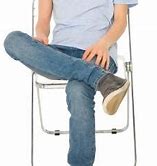
Isometric Strain happens more often than you realize. It's what happens to people who stand in one place for a long time with one or both knees 'locked'. Or think about crossing your legs for a long time when sitting - that torque on your body is severe. Some people cross their ankles when they sleep. Doing so causes the knee joint of the top leg to hyper-extend for hours possibly, constantly pressing on one part of the knee joint.
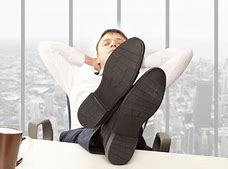
Elbows and wrists often experience isometric strain when we sleep. Do you lie with your wrist or elbow bent tight and under your head or body as you sleep? Maybe you sit for hours each day in front of your computer with your head resting on your wrist. Lying on your side propped up on one elbow as your read or watch TV can put unusual compressive strain on your shoulder joint.

There are things that we do, that maybe you haven't thought about that cause isometric strain in different parts of your body. If you are unsure what caused your injury, think about this possibility as well. If this is the culprit then you may need to correct that habit, or you risk causing the injury over and over again. You will need to stop it for some time to at least let your body heal.
This goes for your tendons and ligaments, bones, cartilage and nerves and the other tissue in your joints. If they get squeezed under even modest pressure for a very long time, they can get damaged.

With Isometric Strain, you usually don't notice it when you're actually doing the damage.
This makes it hard to figure out, because you end up feeling the pain during other times of activity.
It is quite possible that the activity you are doing when you feel tendonitis pain isn't the root cause of the problem.
But the pain is an indication that your situation is bad enough that the painful activity may start to make your condition worse.
By this point, all sorts of activity may start to make your situation worse.
The good news is, that if you correct the underlying cause and treat the condition so it heals, you may be able to resume your favorite activity and never have to worry about developing tendonitis again.

Your joints have a lot of protection built into them as well. Often a tendon or ligament has a protective pad along side it, called a bursa, to protect your tendon from rubbing against a nearby bone or other ligament. The bursa is both a cushion and a slippery surface that protects your body's rope when it is pulling on the bone.
By design, your bursa and tendon are expecting off and on pressure, like when you are walking or running or doing any repetitive motion. If you keep it under a lot of pressure for a very long time, though, the bursa can get squeezed flat and the tendon's protection from the bone is compromised. After a while, the ligament or tendon gets squeezed too. That rope like tissue gets squished, and with no lubricant or fluid buffer it's prone to damage. Then, if you move suddenly, maybe not even with a lot of effort, a tear is much more likely.
You hear it all the time when people talk about tendon injuries. "I was getting out of the car and...", or "I was sitting there and when I went to get up...", or "I went to get out of bed and I just buckled..." The common thread is they were still for a long time and then went to move. Quite possibly, when they were still, their joint and tendon was experiencing gentle but long isometric strain that set them up for injury with that first motion.
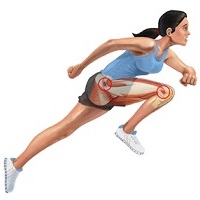
We want to be clear here: Overactivity that causes a Repetitive Strain Injury is when you do something excessively strenuous over and over. If the activity is light, you can do it endlessly and never have to worry about developing an injury like tendonitis. If the activity is light, everything works as it should, and the joint moves freely, without damage. Walking, running, lifting medium to light weights repeatedly, constant bending of the knee - these are all considered light activity. Even a whole lot of light repetitive activity is not a concern for a healthy joint or tendon. Your tendon is designed to do that type of activity repeatedly.
If the activity is heavy though, if you are putting a lot of pressure on the joint during the motion, tissue can rub that shouldn't. Bones can push together or ligaments and tendons can get squeezed to the point where the protection like bursae get diminished. Some tissue that shouldn't touch each other start to rub. If it happens occasionally, that's not a problem. The bursae and sheath are there for that purpose, to be a bumpers and wear pads during times of heavy strain. But there's a limit when it comes to heavy activity.
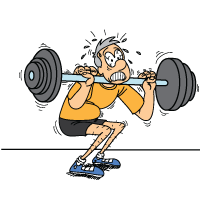
If you do a heavy load activity over and over and over again so that the parts of your joint are constantly bumping and grinding on each other, then it is possible they get worn down over time faster than they can regenerate. If the load is very heavy and your tendon is under constant serious and repetitive strain, that can cause tendon damage. When that is the case, a doctor will tell you the joint has developed tendonitis or one of those related conditions.
The tendon injury can go away if you let up on the activity and let the tendon heal. Often, active people develop tendinosis in their tendons that they don't even realize is there. And the body's response to tendinosis is, again, to start producing synovial fluid to help the tendon heal. When it is mild enough that you don't notice it, but if it persists for a long time, then that can cause other tendon injuries to develop. With constant wear, the previously unnoticed tendinosis can develop into tendonitis or tenosynovitis.
Again, it's worth noting that if you are doing mild repetitive activity, you are not likely to sustain any injury no matter how much you do it. If the ligaments and tendons are not being pushed hard enough to bump and rub a lot, then your body can do that activity forever. If the tendons and ligaments are not being squeezed excessively during repetitive motion then you will be fine. So don't get confused by the terms 'overuse injury' and 'repetitive strain injury'. That sort of injury only occurs if the excessive activity is also excessively strenuous on the tendon.
Never wear compression bandages or straps or tight elastic products around your body parts during times of repeated activity. That is a recipe for abrasive strain that results in tissue damage and eventually tendonitis or even arthritis and/or bursitis. Yes, companies make them and sell them to make money, but they are only likely to injure the person wearing them. Bands and straps may look cool, but they are definitely compromising your health if you wear them during activity.
This is something you hear about with professional athletes all the time. If you have been doing a demanding physical activity for many months or years and then take a few weeks or months off, you have a much greater chance of injuring your tendon or ligament when you return to that activity. This is because your body's protective system, responds to your level of activity over time.
The same way your muscles grow, or your endurance improves when you do repetitive exercise, your body's denfences beef up too. When you are regularly active your body gets in the habit of producing more synovial fluid so the pipes are better lubricated and the bursas are more fully padded. Your ligaments and tendons and cartilage are living tissue and as the demands on your body increase regularly over time, they develop too. And, when you take an extended break from what used to be normal activity, your ligaments and tendons adapt in reverse, and they become more vulnerable again.
So often, whether at work or at play, people body's get used to lifting heavy weights or doing a regular strenuous motion. Their body gets used to it and good at it. Then, for some reason they take an extended break of 2 or 3 months, maybe because of lifestyle demands or perhaps another injury. When they return to that acivity after the long break, people often try to resume their previous level of performance quickly and that's when injury occurs.
How many times do you hear about athletes coming back from one injury and they tear a ligament or tendon in their first or second time back in the game? Too often. It's often not even the same body part as their original injury, but while they were recovering, their entire body atrophied a bit. That happens to regular people too. If you are going back to significant activity after any extended break, it is very important to go back slowly. 'Slowly' is always more slow than people would like, but if you want to minimize the chance of a tendon tear, ramping up very slowly is a very wise choice.
A torn tendon or ligament is going to last until your body successfully heals the underlying injury. By the time you started researching tendonitis, you have probably had the injury for a long time already. There's no doubt about it, something in your lifestyle is causing your injury to persist - your body can't heal the problem as fast as it's getting reinjured. So, it is unlikely that it will just go away, unless you change something about your activity.
In many, many cases, you did something once that caused you to have an injury in the moment, and it didn't have a chance to heal, and the injury has persisted ever since. That's the best scenario, because if that's the case, if you can allow your body to heal and get past that injury, you are likely to be able to return to the same activity level as before and never have the problem again. Some people get to this point and may not realize what is the root cause. No matter what the cause, though, you have an injury and you need to let it heal. If you heal your injury, regardless of the reason it started in the first place, your pain and inflammation will go away and you will likely be able to resume normal life. That is, if this whole ordeal is dealt with properly...
Regardless of how your tendon injury started, you need to go easy on your tendon to let it heal. Once it's injured you may feel pain during lots of activities that would not have otherwise bothered you when you were healthy. If you feel pain doing any activity, that is a sign that your actions are tearing your injury further and you need to stop right away. Don't drive through the pain of any injury. Never drive through the pain. If you don't respect the pain your injury will possibly remain forever.
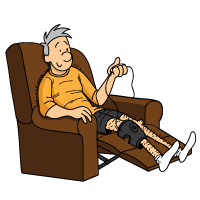
For a little while - not forever - it is really helpful to give your tendon a rest. In many cases, resting your affected body part for a few weeks will give it time to heal to a point that your body gets ahead of the healing / reinjury cycle. It's important to realize that once the pain goes away, your underlying injury is definitely not healed completely, so take it easy and go back to regular life gradually once the pain and swelling are gone. If you want to be more proactive about healing the problem, you can click here to visit the Recommended Treatments page.
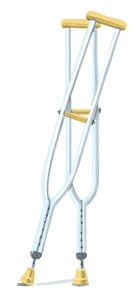
If you want your tendon injury to go away as quickly as possible, you need to rest the affected part. Avoid any physical activities that could cause further injury. If your tear developed from a known injury or condition, do your best to avoid the activity that caused the problem in the first place. And, if it hurts during other activites now too, you need to go easy on those. Avoid any activity that causes you to experience pain. Never drive through the pain. If it's in your hips or lower, consider using crutches to keep your body weight off the area and avoid re-injury.
Do regular ColdCure® treatments to control the pain and swelling in the tendon. The compression during each treatment helps stabilize any reinjury after activity. Cold Compression relieves pain and reduces the size of those backwards reinjury steps.
You can also focus on healing your underlying injury with regular BFST® treatments. This combination will work to finally get rid of your tendon issues.
Around the 4-6 week mark you can start doing some light stretching and strengthening exercises. Slowly work your way back to your regular level of activity. Continue doing BFST® treatments long after the pain and any lump disappear to maintain the healing you've done. Do a ColdCure® treatment if you experience any flare-ups of pain and swelling and after any significant activity.
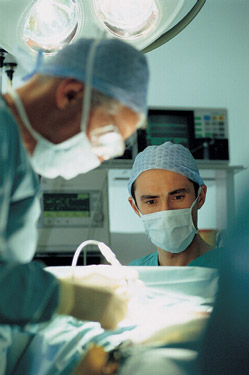
You don't have to undergo surgery in order to heal a torn ligament or tendon. You can get your body to heal completely with conservative treatments. However, it's possible that your underlying knee condition or injury requires surgery. These are very rare cases.
If surgery is your only option, make sure your post-surgery recovery goes as smoothly as possible by using BFST and ColdCure. Use a ColdCure® Wrap to reduce the inflammation and relieve the pain for the first few days following surgery. Once the inflammation has gone down, promote blood flow to the injured area using a BFST® Wrap. This will improve your circulation and help you heal faster.
Painkillers mask the pain, causing you to continue to stress and injure your tendon. This will only make your condition worse. It is understandable that people need relief from the pain, so if you have to take painkillers, restrict them to times when you are resting for an extended period. Unless you think the root cause has to do with your sleeping position, you can use painkillers to help you sleep. Using them when you are active is a recipe for permanent damage. Your choice of pain killers is important. You can give us a call to discuss which ones are best.
A ColdCure® Wrap is designed to relieve the pain associated with torn connective tissue. This safe and effective pain reliever is also great at bringing down swelling and inflammation. The ColdCure® Wrap is incredibly soothing and provides support and protection for your injury while you wear it. The painkilling element is incredibly powerful and it works instantly - there's no 20 minute wait like with pills.

A tendon tear can be extremely painful and debilitating. Painkillers such as ASA or acetaminophen are often used to treat the pain but these drugs do nothing to treat the actual condition. In fact, most painkillers are known blood thinners that can have other side effects. Cortisone injections are used in extreme cases but these too are intended only to address the pain. They do not promote healing of the injury itself and they put you at a very high risk of further injury.
You don't have to wait for endless months in pain. You can heal much more quickly with the right treatment. For a tendon injury, blood flow is the most critical element in rapid recovery. Blood Flow Stimulation Therapy™ (BFST®) gives your tendon the blood flow it needs to heal quickly and completely.
Blood into and out of tendons comes only from the two ends. Promoting that blood flow is essential to recovery. Often in the middle of the tendon, within the sheath, it's too far from the ends to get much blood flow. In those sections, a lot of exchange of resources and waste with the tendon cells can happen through the synovial fluid and synovial membrane. Synovial fluid replaces the role of blood in some parts of the body, particularly in joints.
For the exchange, where synovial fluid is the transporter rather than blood, circulation of synovial fluid is aided by motion of the tendon. But that motion requires no load at all. Just moving the joint causes the tendon to move back and forth and the synovial fluid to get moved around. You don't need to use weights, or strain at all. You don't need to stretch. Just do small simple motion (that causes no pain). Also, stimulating blood flow around the tendon sheath, using BFST, also improves the exchange between the synovial fluid and the blood in the synovial sheath itself.
BFST® brings extra oxygen and nutrient-rich blood to the injured area - a requirement for the body to heal itself. Unfortunately, an injured tendon at rest often has restricted blood flow, which extends your healing time. With a King Brand® BFST® Wrap, blood flow can be stimulated in the area of injury while you are at rest. With improved blood flow and without intense physical activity and the risk of re-injury, you can recover from your tendonitis at a surprisingly rapid rate.
Always do BFST treatments before any physical therapy. This will help improve the benefits of therapy and reduce the likelihood of injury during the activity.
I've had such great success with my baker's cyst! It's really given me noticeable improvements. I'm very happy with the products, so now I've ordered the Back BFST.
Connie from New JerseyColdCure Leg | BFST Knee | Pre-Cut TapeJuly 15, 2022

King Brand® soft tissue rehabilitation medical products are the #1 choice by top Athletic Therapists and Medical Practitioners worldwide. We provide guaranteed results and customer satisfaction. Like all King Brand® products, there simply isn't a better performing option. All King Brand® products come with a 100% satisfaction guarantee. Try our products and if you are not completely impressed, you can send them back for a full refund. We know you will love them though, because hundreds of thousands of people already use them and rave about the results.
Click here to see our Customer Testimonials
King Brand® BFST® and ColdCure® Wraps are FDA Registered medical devices. They are intended to prevent, treat and cure soft tissue injuries and chronic conditions. Part of being an FDA Registered company means that our products are made from high quality, biocompatible materials. These devices are manufactured and tested to the highest safety standards in the industry.